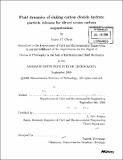| dc.contributor.advisor | E. Eric Adams. | en_US |
| dc.contributor.author | Chow, Aaron C. (Aaron Chunghin), 1978- | en_US |
| dc.contributor.other | Massachusetts Institute of Technology. Dept. of Civil and Environmental Engineering. | en_US |
| dc.date.accessioned | 2010-03-25T15:02:17Z | |
| dc.date.available | 2010-03-25T15:02:17Z | |
| dc.date.copyright | 2008 | en_US |
| dc.date.issued | 2008 | en_US |
| dc.identifier.uri | http://hdl.handle.net/1721.1/53109 | |
| dc.description | Thesis (Ph. D.)--Massachusetts Institute of Technology, Dept. of Civil and Environmental Engineering, 2008. | en_US |
| dc.description | Includes bibliographical references (p. 203-211). | en_US |
| dc.description.abstract | One strategy to remove anthropogenic CO₂ from the atmosphere to mitigate climate change is by direct ocean injection. Liquid CO₂ can react with seawater to form solid partially reacted CO₂ hydrate composite particles (pure hydrate plus unreacted CO₂ and water) with densities several percent above ambient seawater. The most recent field injections at depths of 1500 m in Monterey Canyon resulted in long curved cylinders with diameters - 2.5 cm and lengths up to - 1 m that were observed to sink at - 4 cm/s. This thesis examines whether releasing the partially reacted hydrate particles into the ocean at - 100 kg/s of CO₂ (roughly the output of one 500 MW coal power plant) is able to create sufficient dilution to minimize the impact on marine life. We developed a drag coefficient model for cylindrical particles in free fall. Applying the new drag coefficient model to recently observed field injections to predict their descent, the recently produced field particles were estimated to have had a ~ 16% reaction efficiency and to have sunk 100 m before completely dissolving. Ambient density stratification and currents will also affect particle descent, and in turn the dilution of dissolved CO₂. Three methods of injection of composite particles were evaluated, each with unique merits. Firstly, we can release hydrate particles (with a range of reaction efficiencies) continuously from a moving ship. This is shown to provide excellent dilution of the discharged CO₂. Second, we can release them from a stationary pipe to create a plume that generally sinks further than individual particles. | en_US |
| dc.description.abstract | (cont.) However we show numerically that, while this method appears to be the most practical from an engineering standpoint, the dilutions and sequestration depths are highly dependent on ambient conditions. The third method involves constructing a shroud around a fixed source to shelter the plume from effects of ambient stratification and current. The shroud also serves as an inverted chimney, inducing a down draft that transports the dissolving particles to a depth of lower ambient distur-bance. Laboratory measurements using particle image velocimetry (PIV) shows that the induced flow depends on the shroud length and diameter, as well as the particle buoyancy and size. | en_US |
| dc.description.statementofresponsibility | by Aaron C. Chow. | en_US |
| dc.format.extent | 211 p. | en_US |
| dc.language.iso | eng | en_US |
| dc.publisher | Massachusetts Institute of Technology | en_US |
| dc.rights | M.I.T. theses are protected by
copyright. They may be viewed from this source for any purpose, but
reproduction or distribution in any format is prohibited without written
permission. See provided URL for inquiries about permission. | en_US |
| dc.rights.uri | http://dspace.mit.edu/handle/1721.1/7582 | en_US |
| dc.subject | Civil and Environmental Engineering. | en_US |
| dc.title | Fluid dynamics of sinking carbon dioxide hydrate particle releases for direct ocean carbon sequestration | en_US |
| dc.type | Thesis | en_US |
| dc.description.degree | Ph.D. | en_US |
| dc.contributor.department | Massachusetts Institute of Technology. Department of Civil and Environmental Engineering | |
| dc.identifier.oclc | 503003996 | en_US |
